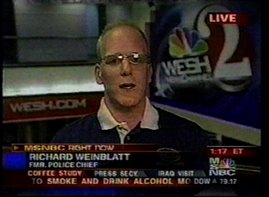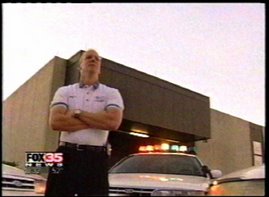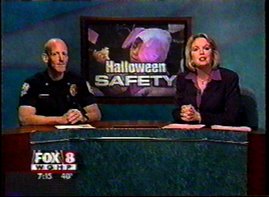Taser International is trumpeting its 51st lawsuit dismissal over the sometimes controversial Taser less-lethal component in law enforcement's tool bag. Many people jump up and down in knee jerk reactions over the Taser. I am a Taser instructor and teach the topic in our Seminole Community College Basic Law Enforcement Academies. I've even been shot in the back by the Taser and lived (quite happily) to tell about it in less then a minute after the probes hit me. See the video below.
Like much that happens in police work, it is hard to see the successes as they do not make headlines. Just as when you take a drunk driver off the road or a gun off a drug dealer, if the case goes south later on on a technicality, you could make the argument that at least the drunk is off the road or the gun is off the street. It is hard to quantify or put your finger on the ephemeral possibility of what was avoided.
So too is the use of the Taser as it is hard to know how may deaths exactly the 50,000 volt ECW -it is dubbed under the generic moniker of ECW (Electronic Control Device) by the Florida Department of Law Enforcement (FDLE)- have helped to avoid. The media loves to ponder the culpability of the Taser in deaths that have occurred after the use of the device (hence my Taser death interviews with CNN Headline News and MSNBC).
I believe that the Taser saves more lives than it takes (if any). Police officer and deputy sheriff injuries and injuries to suspects have gone down. Of course, it helps that the training for officers deploying the Taser has gotten better. No longer are officers encouraged to Taser individuals who are on rooftops. You see, those folks end up falling off the roof when the Taser hits them and, of course, they can't put their arms out to break their fall.
As Taser has settled in to the police landscape, officers and their respective agencies have learned that the Taser is not a one size fits all device. It is not appropriate for all circumstances.
Some history may help to put this all in perspective. Some of the same hysteria and police overuse happened when Pepper Spray hit big (full disclosure: I am also a pepper spray instructor). Oleoresin Capsicum (OC) is not to be confused with Mace as the former is organic and operates beyond just pain compliance and the latter is man-made and is not effective on some drug or alcohol induced individuals who are feelin' no pain.
A few in-custody deaths occurred due to over or mis use of pepper spray on the part of officers. Once some training and departmental policy modifications took place, the problems seemed to abate. Hog tying, what is now sometimes referred to as three point restraint, has been restricted due to its tie with positional asphyxia. Simply put, placing an obese man suffering acute cocaine intoxication on his stomach is not a wise move.
Fast forward to the 21st Century and the advent of the Internet. The new era of communications has made the Anti-Taser movement much more virulent than the anti-pepper spray movement that preceded it. Pepper spray's enemies were not able to garner the support and vitriol of the Internet bearing anti-Taserites.
The move affot in some places to restrict the use of the Taser as an extremist knee-jerk reaction is not healthy for law enforcement or the public we serve. A more measured response backed by well-thought out policies and training, with controlled deployment in the field by officers, is the key to restoring the public faith. Victorious in the civil litigation arena does not serve to fully convince the public. We need to do a better job at using the Taser and explaining its deployment.
Tuesday, June 26, 2007
Taser Continues to Thrive as 51st Lawsuit Dismissed
Labels: International, police, Richard Weinblatt, Taser, Tazer
Thursday, June 21, 2007
Sad End to New Orleans Police Beating Tragedy

As many of you may have seen in the news recently, one of the New Orleans Police officers caught on video tape and accused of beating 64-year-old retired school teacher Robert Davis committed suicide about one month before his trial was slated to begin. Former "Big Easy" cop Lance Schilling, 30, killed himself at his home in suburban Metairie, LA.
As I wrote in a January 4, 2006 PoliceOne.com article and have also been quoted in England (See my blogger post from February 27, 2007), he used his gun to end it with a gunshot to the roof of his mouth adding to the statistics of police officer suicides.
While I do not condone what it appears these officers did in a highly publicized way on October 8, 2005 to Mr. Davis and the image of a battered post-Katrina New Orleans Police Department, I would never wish such a tragedy to be compounded by Schilling's final act. I am sure his family is suffering and, likewise, the closure is surely not there for Mr. Davis and his family.
The beating was videotaped by an Associated Press Television News crew and was played over and over on newscasts around the world. One of the APTN news crew, producer Richard Matthews, was captured on tape in the same incident being battered by another officer, Stuart Smith. That case was dropped due to an apparent violation of Garrity procedures. Smith's statements to internal investigators were turned over to the District Attorney's office for criminal action.
The move caused Smith's lawyer, Eric Hessler, to allege a Garrity violation of his client's rights. That is when an officer is compelled to talk to his or her employing law enforcement agency with the resulting statement to be only used in the administrative proceeding; not for any criminal prosecution.
While I hate to draw conclusions on officers cations, the era of video tape affords more information than ever before. I was appalled by what I saw on the tape, especially since the apparent actions of the officers flew in the face of the countless officers and deputy sheriffs that do their job admirably and with honor each and every day. But of course, the public does not have a tape of them doing such noble service played endlessly in the 24 hour news cycle. Officers beating people quite simply tarnishes the badge. No professional officer should want to stand behind bad policing.
I was so concerned about the situation and the understandable backlash from the public that I wrote an editorial on it for the Orlando Sentinel daily newspaper here in Florida. The Orlando Sentinel published my editorial, "A rip in fabric that holds law enforcement together," on October 19, 2005. Here is the text of it:
Like many Americans, I watched with great interest, and with increasing anger, the recent beating of a 64-year-old retired schoolteacher on the streets of New Orleans. The glare of the public eye almost wasn't there. A New Orleans police horse appeared to be made to walk backward, apparently to block the probing eye of the TV camera.
Unlike many Americans, as a former police chief and current manager of a police academy, I have learned that the facts of alleged police misconduct are many times at odds with the information that comes out publicly. Time after time, I would investigate complaints against officers, only to find the issue to be clouded in misunderstanding or sometimes even blatant lies against an officer making a lawful and professional arrest.
However, even in the eyes of law-enforcement professionals across the nation, who tend to hold back criticism of fellow officers until the very last shred of damning evidence is in, the New Orleans situation was very disturbing. Every officer and police instructor I spoke with in different regions of the country had a similar reaction: disgust.
As the picture speaks a thousand words for itself, so, too, does the obvious crossing of the line with Robert Davis. And while there exists a sliver (and I mean a tiny sliver) that there could be some truth in the position of the arresting officers, an even more unsettling development out of the same situation was the New Orleans police officer who threatened and used profanity with an AP television producer while physically pushing him back against a car.
The blatant and open hostility vented by the officer revealed a brand of law enforcement that could not support a bona fide arrest of that producer and could offer no credible explanation for the verbal barrage of expletives and obvious physical battery. Even if the producer was subject to a legitimate arrest, the officer's behavior was not acceptable.
When I took the oath of a law enforcer years ago, I told myself that the true measure of what separated me from the bullies and predators in our society was not my badge. Rather it was the inner strength I possessed to curb my impulses and shape my behavior so that "I" did not become "them." The badge was but the symbol. The true manifestation of policing was within me.
And the true essence of being an honorable law enforcer is in most police officers, deputy sheriffs, and state troopers. New Orleans is a situation that stretches the thread that binds the police fabric together. It pulls at the material and frays the edges, making it easy for an officer to fall victim to his impulses to loot sunglasses or take TVs.
The hidden strength in the blue fabric should be the presence of other interwoven blue threads that lend support for those rare moments of personal weakness. It behooves the rest of us in this noble profession to see the signs of tired and stressed threads and give them support.
When the officer pushed the media producer against the car, I observed several other officers that stood by and watched. Those officers should have been the "cross thread" that gave strength to the situation and intervened. Better yet, maybe they could have foreseen the buildup and moved their colleague down the street to cool off.
The image of New Orleans police as bullies and intimidators on national television does not help the cause of an agency that has strived for some 10 years to break its negative reputation. That impetus to clean up the department's image began with the arrival of former police Superintendent Richard Pennington (now the police chief in Atlanta) and has come full circle with the recent events.
Nor, for that matter, does it help the image of police professionals elsewhere. While all would acknowledge that the stress on the New Orleans officers during this post-hurricane period has been inordinate, the oath has no clause that makes for
allowances of police abuse and brutality.
My 4-year-old son interacts with police officers regularly, pretends that he is one, and wants to be one some day. I am ashamed to say that I had to have him leave the room when the images of those officers breaking their oath came on the television again and again. My little, wide-eyed boy did not yet need to see what happens when the blue fabric that holds the law-enforcement profession together is ripped.
Richard B. Weinblatt is professor/program manager of the Criminal Justice Institute for Seminole Community College in Sanford. He may be reached via his Web site www.policearticles.com.
Schilling's suicide is a tragic end to a sad tale. I hope it serves as a cautionary lesson to other officers who contemplate dishonoring the badge.
Sunday, June 3, 2007
Bulletproof Vest Interest Continues
It seems that the interest in bullet proof vests on the part of the media has not waned (please see blog post below). The day after I did the bullet proof vest show and tell in the downtown Orlando studios of Central Florida News 13, Fox 35 10:00 News had me come to their WOFL-TV studios in Lake Mary, FL, to film an interview with reporter Kelly Joyce.
Kelly, upfront and gracious as always, told me that piece would be fairly short and air within the first 15 minutes of the newscast. Out of the sound bites I offered them, Fox 35 picked my sentiments that agencies should make wearing a bulletproof vest part of a mandatory officer safety policy.
Luckily for the deputy sheriffs who were shot (remember, this was the incident that sparked the interest in law enforcement bulletproof vests), they wore their vests. One deputy took a round to the left chest and the vest stopped it.
Maybe these segments will encourage more officers to wear their vests and perhaps budget managers at smaller agencies will see the need to supply all officers with bulletproof vests. You can view the Fox 35 10:00 News video below.






































